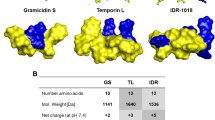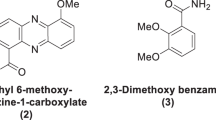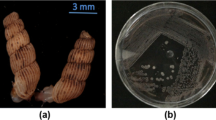Abstract
The time-kill studies using pargamicin A against Staphylococcus aureus and Enterococcus faecalis were performed. The effects of the incorporation of radioactive precursors into macromolecules, membrane potential and function using fluorescent dyes were also examined. These studies revealed that rapid bactericidal activity of pargamicin A correlates with the perturbation of bacterial cell membrane potential and membrane function.
Similar content being viewed by others
Introduction
The widespread emergence of multidrug-resistant Gram-positive pathogens is a high threat to our social health, especially in immunocompromised hosts. Among these pathogens, methicillin-resistant Staphylococcus aureus (MRSA) and vancomycin-resistant Enterococcus faecalis/faecium (VRE) are the most intractable pathogens and frequently isolated from patients. MRSA and VRE often cause simultaneous complex nosocomial infections. The current drugs available for treatment are less active against VRE when compared with MRSA, as shown in Table 1. There are only a few limited options for treatment of both pathogens, such as the use of linezolid,1 quinupristin/dalfopristin,2 daptomycin3 and tigecycline.4 Although these drugs have been recently launched, drug-resistant strains against these drugs have already been clinically isolated.5, 6, 7, 8, 9, 10, 11
In the course of our screening program for new antibiotics, which are active against both MRSA and VRE, pargamicin A (PRGA) as shown in Figure 1, was isolated from the soil actinomycete strain Amycolatopsis sp. ML1-hF4.12 PRGA shows higher MIC against MRSA than VRE. To clarify its mode of action, we studied the correlation of the bactericidal activity of PRGA with membrane depolarization and loss of membrane function.
Materials and Methods
Time-kill study
Time-kill studies were conducted using S. aureus Smith and E. faecalis JCM5803 strains grown in nutrient and Heart infusion broth (Difco, Franklin Lakes, NJ, USA), respectively. The antibiotics that were added were used at the MIC as well as at two and four times this concentration. The initial inoculums contained 5 × 107–8 × 107 CFU per ml. Viability counts in antibiotic-treated cultures were performed at 0, 5, 15, 30 and 60 min after addition of antibiotics. The colony units were determined from plates forming 30–300 bacterial colonies.
Inhibition of macromolecular synthesis
Inhibition of macromolecular synthesis was assayed by measuring the incorporation of radioactive precursors into the precipitate with 10% trichloroacetic acid for peptidoglycan, fatty acid, DNA, RNA and protein synthesis. S. aureus or E. faecalis grown in nutrient broth at the early exponential phase of growth, in which the OD density at 600 nm (OD600) was approximately 0.3, were seeded into 96-well plates using 90 μl of culture per well, and then preincubated at 37 °C for 5 min with antibiotics. The nutrient broth consisted of 1% polypeptone (Wako, Osaka, Japan), 1% fish meat extract (Kyokuto, Tokyo, Japan) and 0.2% NaCl (Wako) in deionized water (pH 7.0 before sterilization). The following radiolabeled compounds were added to cells for the indicative assays: peptidoglycan assay, 1 μCi of N-acetyl-D-[1–3H] glucosamine (GE Healthcare Bioscience, Fairfield, CT, USA); fatty acid assay, 1 μCi of [1-14C] acetate (GE Healthcare Bioscience); DNA assay, 1 μCi of [methyl-3H] thymidine (GE Healthcare Bioscience); RNA assay, 1 μCi of [5,6-3H] uridine (GE Healthcare Bioscience); and Protein assay, 5 μCi of L-[4,5-3H] leucine (GE Healthcare Bioscience). After incubation for 10 min at 37 °C, the reaction mixtures were quenched by adding an equal volume of 10% TCA. The reaction mixtures were further incubated for 10 min at room temperature, and then the solutions were transferred into 96-well filter plates (MultiScreen HTS; Millipore, Billerica, MA, USA) and the filters were washed five times with 5% TCA. After drying, the radioactivity of the filters were counted using a liquid-scintillation counter (Tri-Carb 2800TR, PerkinElmer, Waltham, MA, USA).
Membrane potential assay
Membrane potential was measured by the method described previously,13 using the membrane potential-sensitive fluorescent dye DiSC3(5) (Molecular Probes, Carlsbad, CA, USA). In the case of the daptomycin assay (Funakoshi, Tokyo, Japan), 138.8 μg ml–1 of CaCl2 (50 μg ml–1 of Ca2+) was further added to the suspension. The fluorescence change (excitation: 615 nm, emission: 665 nm) was measured at a scheduled time after addition of the antibiotics by a Multilabel Plate Reader (EnVision; PerkinElmer). The fluorescence of DiSC3(5) decreases as the dye partitions to the surface of polarized cells, and depolarization prevents partitioning and can release the bound dye into the media. The polarized cells produce a low fluorescence, whereas depolarized cells show a high fluorescence. Hence, the increase of DiSC3(5) fluorescent is indicative of membrane depolarization.
Membrane function assay
Membrane function was monitored by the uptake of membrane-impermeable fluorescent indicator To-Pro-3-iodide (Molecular probes). Cells of E. faecalis or S. aureus were harvested, washed, resuspended in the buffer containing 5 mM HEPES and 5 mM glucose (pH 7.2) in a similar manner as the previous description in the membrane potential assay,13 and plated into black polystyrene 96-well plate at 95 μl per well (Corning Coster, Corning, NY, USA). In the case of the daptomycin assay, 138.8 μg ml–1 of CaCl2 (50 μg ml–1 of Ca2+) was further added to the suspension. The plate was incubated at room temperature for a scheduled period after addition of the antibiotics, and further incubated at room temperature for 5 min after the addition of 1 μM of To-Pro-3-iodide. The fluorescent change (excitation 615 nm, emission 665 nm) was measured by a Multilabel Plate Reader (EnVision; PerkinElmer). An increase in To-Pro-3-iodide fluorescent is indicative of the loss of bacterial membrane function and membrane disorder.
Results and Discussion
Time-kill curve of PRGA
The MICs of PRGA against S. aureus and E. faecalis from the microdilution assay were 2 and 1 μM, respectively, and the MIC of vancomycin and arbekacin against S. aureus was 1 μM.
As shown in Figures 2a and b, PRGA shows time- and dose-dependent bactericidal effects on both S. aureus and E. faecalis, similar to arbekacin (Figure 2d). Vancomycin does not show this dose-dependent bactericidal effect but shows a time-dependent effect (Figure 2c). PRGA shows rapid bactericidal activity at concentrations two and four times greater than the MIC, producing a greater than 10- and 20-fold decrease in viability, respectively, within 30 min against both S. aureus and E. faecalis. It is worthy to note that the bactericidal activity of the PRGA against S. aureus is more potent than that of arbekacin at 5–15 min after treatment.
Effect of PRGA on macromolecular synthesis
Such rapid bactericidal activity of PRGA prompted us to examine its mode of inhibition on macromolecular synthesis by studying the incorporation of radioactive precursors. Vancomycin, arbekacin and novobiocin show selective inhibition in five areas of macromolecular synthesis, as shown in Figures 3d–f. Vancomycin is an inhibitor of cell wall polymerization and shows the selective inhibition of cell wall synthesis with its IC50 (0.7 μM) parallel to its MIC (1 μM). PRGA inhibited the synthesis of DNA, RNA, protein, fatty acid and peptidoglycan in the same manner with their IC50's of approximately 0.7 μM (Figures 3a and b) in both S. aureus and E. faecalis. Such a multiple inhibition of macromolecular synthesis might be derived from a steep effect on bacterial cells. Melittin also showed inhibition of multi-macromolecular synthesis, similar to PRGA (Figure 3c). Melittin (NH2-GIGAVLKVLTTGLPALISWIKRKRQQ-CONH2) is a cationic hemolytic peptide isolated from the European honeybee, and is known to show strong lytic activity against both eukaryotic and prokaryotic cells by binding to the membrane, resulting in membrane disorder.14
Inhibition of macromolecular synthesis by pargamicin A against S. aureus Smith (a) and E. faecalis (b), and melittin against E. faecalis (c), as well as vancomycin (d), arbekacin (e) and novobiocin (f) against S. aureus Smith. The percentage incorporation of DNA (squares), RNA (triangles), protein (solid triangles), cell wall (solid circles) and fatty acid (circles) after incubation for 10 min are plotted versus drug concentration.
Membrane potential assay
To examine the inhibition pattern of PRGA, the effects on the enterococcal and staphylococcal membrane potential were investigated using the membrane potential-sensitive fluorescent dye DiSC3(5). Similar to melittin (Figure 4c), PRGA rapidly dissipated the membrane potential, when PRGA was used at a dose above the MIC, in a dose-dependent manner (Figures 4a and b). These effects correlated with the bactericidal activities (Figures 2a and b). Vancomycin was used as a negative control and showed no effect on membrane potential as previously reported.13 In addition, arbekacin also did not show any effects despite its potent bactericidal activity (Figures 4d and e). Daptomycin was used as a positive control for this assay and it also dissipated the membrane potential, but its effect was very weak when compared with PRGA and melittin.
Effect of pargamicin A (a, b), melittin (c), vancomycin (d), arbekacin (e) and daptomycin (f) on membrane potential. Each point is the mean±s.d. of four estimates. Membrane potential assays were evaluated in the absence (squares) or presence of the following concentrations of drugs: 1 × MIC (open circles), 2 × MIC (solid triangles), 4 × MIC (solid squares) and 8 × MIC (solid diamonds).
Membrane function assay
We sought to confirm whether membrane depolarization by PRGA caused the loss of membrane function. Vancomycin and arbekacin seemed to have no effect (Figures 5d and e). However, daptomycin slightly dissipated the membrane potential but showed no effect on membrane function, which is in agreement with the report (Figure 5f).15 PRGA, as shown in Figures 5a and b, caused the rapid disruption of bacterial membrane function in a dose-dependent manner, which was somewhat different compared with the effects of melittin (Figure 5c), suggesting that they have different modes of action. This result, in conjunction with the results from the time-kill curve and the membrane potential assays (Figures 2a, b and 4a, b), indicated that the cell viability was decreased after PRGA treatment, and this was in proportion to the changes in membrane potential and membrane function.
Loss of membrane function by pargamicin A (a, b), melittin (c), vancomycin (d), arbekacin (e) and daptomycin (f). Each point is the mean±s.d. of four estimates. Membrane function assays were evaluated in the absence (squares) or presence of the following concentrations of drugs: 1 × MIC (open circles), 2 × MIC (solid triangles), 4 × MIC (solid squares) and 8 × MIC (solid diamonds).
PRGA has a unique structure and shows excellent antimicrobial activity against Gram-positive bacteria, including MRSA and VRE. In this study, we demonstrated some interesting biological profiles of the structurally unique PRGA. It is very interesting to note that despite the large difference in the structure between PRGA and melittin, they show similar biological activities. The MICs of PRGA against enterococci were lower than against staphylococci, and the influences of PRGA toward staphylococcal and enterococcal membrane were quite similar, suggesting that PRGA has a higher affinity to enterococcal membrane. Rapid bactericidal effects with PRGA were greater than those with vancomycin and arbekacin, and correlated with its influence on the function of bacterial membrane. Daptomycin, a recently launched drug for the treatment of MRSA/VRE infectious diseases, also disrupts the membrane potential but not membrane permeability, and its mode of action has shown that a daptomycin oligomer forms a potassium channel in the bacterial membrane, resulting in rapid membrane depolarization and cell death.15 PRGA causes disruption of the membrane potential, leading to loss of membrane function, which is unlike the daptomycin mechanism. The anti-MRSA/VRE compounds that exert an effect on the membrane such as PRGA and daptomycin show excellent MICs against staphylococci and enterococci, suggesting that bacterial membrane may be a good target for screening of new anti-MRSA/VRE drugs.
References
Spangler, S. K., Jacobs, M. R. & Appelbaum, P. C. Activities of RPR 106972 (a new oral streptogramin), cefditoren (a new oral cephalosporin), two new oxazolidinone (U-100592 and U-100766), and other oral and parental agents against 203 penicillin-susceptible and -resistant Pneumococci. Antimicrob. Agents Chemother. 40, 481–484 (1996).
Robert, J. F. In vitro activity of RP 59500, a semisynthetic injectable pristinamycin, against staphylococci, streptococci, and enterococci. Antimicrob. Agents Chemother. 35, 553–559 (1991).
George, M. E. et al. In vitro and in vivo activity of LY 146032, a new cyclic lipopeptide antibiotic. Antimicrob. Agents Chemother. 30, 532–535 (1986).
Peterson, P. J., Jacobus, N. V., Weiss, W. J., Sum, P. E. & Testa, R. T. In vitro and in vivo antibacterial activities of a novel glycylcycline, the 9-t-butylglycylamido derivative of minocycline (GAR-936). Antimicrob. Agents Chemother. 43, 738–744 (1999).
Lee, D. K. et al. Antimicrobial activity of mupirocin, daptomycin, linezolid, quinupristin/dalfopristin and tigecycline against vancomycin-resistant Enterococci (VRE) from clinical isolates in Korea (1998 and 2005). J. Biochem. Mole. Biol. 40, 881–887 (2007).
Pillai, S. K. et al. Daptomycin nonsusceptibility in Staphylococcus aureus with reduced vancomycin susceptibility is independent of alternation in MprF. Antimicrob. Agents Chemother. 51, 2223–2225 (2007).
Luh, K. L. et al. Quinupristin-dalfopristin resistance among Gram-positive bacteria in Taiwan. Antimicrob. Agents Chemother. 44, 3374–3380 (2000).
Besier, S., Ludwig, A., Zander, J., Brade, V. & Wichelhaus, T. A. Linezolid resistance in Staphylococcus aureus: gene dosage effect, stability, fitness costs, and cross-resistances. Antimicrob. Agents Chemother. 52, 1570–1572 (2008).
Werner, G., Gfrorer, S., Freige, C., Witte, W. & Klare, I. Tigecycline-resistant Enterococcus faecalis strain isolated from a German intensive care unit patient. J. Antimicrob. Chemother. 61, 1182–1183 (2008).
Jones, T. et al. Failure in clinical treatment of Staphylococcus aureus infection with daptomycin are associated with alternations in surface charge, membrane phospholipids asymmetry, and drug binding. Antimicrob. Agents Chemother. 52, 269–278 (2008).
Peleg, A. Y., Adams, J. & Paterson, D. L. Tigecycline efflux as a mechanism for nonsusceptibility in Acinetobacter baumannii. Antimicrob. Agents Chemother. 51, 2065–2069 (2007).
Igarashi, M. et al. A novel cyclic peptide antibiotic from Amycolatopsis sp. J. Antibiot. 61, 387–393 (2008).
Higgins, D. L. et al. Telavancin a multifunctional lipoglycopeptide, disrupts both cell wall synthesis and cell membrane integrity in methicillin-resistant Staphylococcus aureus. Antimicrob. Agenrts Chemother. 49, 1127–1134 (2005).
Williams, J. C. & Bell, R. M. Membrane matrix disruption by melittin. Biochim. Biophys. Acta. 288, 255–262 (1972).
Silverman, J. A., Perlmutter, N. G. & Shapiro, H. M. Correlation of daptomycin bactericidal activity and membrane depolarization in Staphylococcus aureus. Antimicrob. Agents Chemother. 47, 2538–2544 (2003).
Author information
Authors and Affiliations
Corresponding author
Rights and permissions
About this article
Cite this article
Hashizume, H., Adachi, H., Igarashi, M. et al. Biological activities of pargamicin A, a novel cyclic peptide antibiotic from Amycolatopsis sp.. J Antibiot 63, 279–283 (2010). https://doi.org/10.1038/ja.2010.29
Received:
Revised:
Accepted:
Published:
Issue Date:
DOI: https://doi.org/10.1038/ja.2010.29
Keywords
This article is cited by
-
Echinosporin antibiotics isolated from Amycolatopsis strain and their antifungal activity against root-rot pathogens of the Panax notoginseng
Folia Microbiologica (2019)
-
Valgamicin C, a novel cyclic depsipeptide containing the unusual amino acid cleonine, and related valgamicins A, T and V produced by Amycolatopsis sp. ML1-hF4
The Journal of Antibiotics (2018)
-
Structure and antibacterial activities of new cyclic peptide antibiotics, pargamicins B, C and D, from Amycolatopsis sp. ML1-hF4
The Journal of Antibiotics (2017)
-
Interactions of disulfide-constrained cyclic tetrapeptides with Cu2+
JBIC Journal of Biological Inorganic Chemistry (2013)








